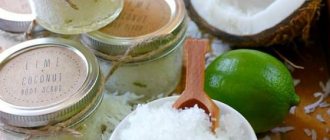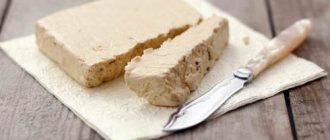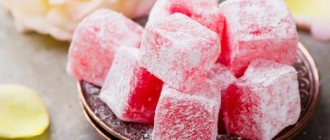For those who like quick answers to their questions: The calorie content of sunflower halva is 523 kcal per 100 grams of product. Read below about the benefits of the product and advice from nutritionists.
When a couple of successful weeks of dieting and several kilograms of excess weight have been left behind, many people have a frantic desire to reward themselves for their efforts with sweets. Indeed, without desserts, diet nutrition soon becomes completely joyless, and life becomes gray and boring.
The body urgently requires endorphins (aka “pleasure hormones”), and the brain, the main consumer of glucose, begins to rebel, not wanting to work productively. In this case, you don’t need to completely give up sweets, you just need to choose the right ones that will bring the greatest benefit to your health.
In this sense, it is difficult to offer anything healthier than halva. When losing weight, it will become a source of many vitamins and microelements. But you should choose the variety with the lowest energy value and the greatest benefit for the body - do not forget that the calorie content of halva is quite high.
You will have to go around more than one store to buy exactly the right dietary variety. In addition, due to its high calorie content, you should treat yourself to this dessert at the appropriate time of day, in a clearly designated quantity, and also not wash it down with certain drinks or mix it with a number of other foods.
Calorie content and chemical composition
There are more than 100 varieties of halva, but traditionally, the first place is occupied by sunflower, second by nut, third by tahini and sesame (purely oriental options). The chemical composition and calorie content of the species differ, which is explained by the variety of raw materials.
| Index | Sunflower | Nut (peanut) | Tahini | Sesame |
| Calorie content per 100 g | 516 | 490 | 507 | 470 |
| Proteins, g | 11,7 | 16,8 | 13,2 | 11,9 |
| Fats, g | 29,8 | 27,9 | 31,1 | 28,7 |
| Carbohydrates, g | 55 | 46,3 | 50,5 | 44,5 |
| Vitamins, mg | ||||
| Ascorbic acid | 3,2 | 4,3 | 5,5 | 4,7 |
| A nicotinic acid | 6,4 | 6,2 | 6,7 | 6,8 |
| Tocopherol | 17,8 | 19,9 | 22,9 | 21,2 |
| Thiamine | 0,9 | 0,8 | 0,8 | 0,8 |
| Riboflavin | 0,1 | 0,1 | 0,12 | 0,11 |
| Retinol | 0,1 | 0,1 | 0,13 | 0,11 |
| Minerals, mg | ||||
| Potassium | 352 | 432 | 275 | 312 |
| Magnesium | 189 | 168 | 304 | 239 |
| Calcium | 311 | 465 | 1500 | 1356 |
| Phosphorus | 298 | 367 | 401 | 345 |
| Sodium | 89 | 57 | 40 | 41 |
| Iron | 31,2 | 29,5 | 49,2 | 45,8 |
Beneficial features
The calorie content of halva is high, but if you consume it in moderation - no more than 30 g per day, then such a dose will not cause much harm to your figure and health. It is noteworthy that each type of halva has its own beneficial properties.
For example, pistachio is especially recommended for use by athletes, as it relaxes muscles and helps restore strength after intense training. Sesame is a natural aphrodisiac, chocolate (glazed) is a powerful antidepressant. All types of oriental sweets also have common beneficial properties:
- Increases the level of hemoglobin in the blood, which is explained by the increased content of iron.
- A large amount of vitamins allows the body to partially compensate for the deficiency of these substances.
- It has a calming effect on the nerves, so much so that it can take on the function of a weak sleeping pill.
- It has a beneficial effect on the heart because it contains potassium and magnesium.
- Helps normalize blood pressure.
- Stops the growth of tumors (both malignant and benign).
- Recommended for use by people engaged in mental work, because it contains glucose and PUFAs necessary to nourish the brain.
- Strengthens intestinal motility and helps eliminate congestion.
- It has a positive effect on the reproductive organs (both male and female) due to the content of folic acid.
- In terms of protein composition, halva is close to meat, therefore, it is a valuable source of amino acids.
- Strengthens the body after long-term illness and surgical interventions.
- Slows down the aging process.
We listen to the experts

Coaches, nutritionists, and athletes also enjoy pampering themselves with halva. This oriental sweet is good for athletes and students, pregnant women and weakened people. You just need to follow some recommendations that apply to everyone who follows a healthy diet and watches their weight.
Anna Chaikina, nutritionist
This specialist says that halva is useful for psycho-emotional and mental stress. This sweetness effectively compensates for the lack of sugar during intellectual stress. It is very useful to give it to children and students during the school year. But you need to eat only a small piece per day, no more than 20-30 g.
Elena Malysheva, doctor, host of the TV program “Health”
This doctor confirms that oriental sweetness stabilizes metabolic processes. The product lowers cholesterol levels in the blood and prevents the formation of atherosclerotic plaques in arterial vessels, slowing down the course of existing atherosclerosis. But we must remember that 100 grams of this sweetness contains 50% of the daily calorie requirement.
When choosing this delicacy, you need to make sure that it does not contain droplets of fat. A good quality product is dry. Too sticky oriental sweetness indicates a high content of caramel. And this is not useful. The sweetness should be stored in a tightly closed jar for no more than 2 months.
Kozlov Alexander, coach
This specialist believes that halva quickly restores an athlete after a workout and gives energy for the whole day. Those who train a lot can safely eat it, they will burn extra calories during training.
Types of halva
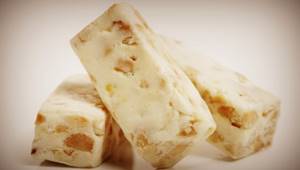
Sunflower
It is most common, at least in Russian-speaking countries. This is not such an ancient product as its eastern “brothers”, because sunflower halva appeared in the 20th century. In addition to vitamins, minerals, PUFAs and protein, it contains phytosterol. This is a biologically valuable substance that removes excess cholesterol, prevents the appearance of atherosclerosis and effectively fights cancer cells. By the way, a deficiency of phytosterol in the body in men provokes the appearance of prostatitis.
Almond
A real delicacy, especially useful for pregnant women and those watching their figure. This is perhaps the lowest calorie variety, which is “poor in fat”, but rich in proteins, vitamin D, potassium and magnesium. The starting raw material is sweet almonds.
Peanut
It is worth paying attention to all women who care about their own health and appearance. This dessert contains a huge amount of “rejuvenating” substances, as well as valuable PUFAs, which help give the skin, nails and hair an absolutely luxurious look. The product has a creamy color and a dense structure, and inside it you can often find pieces of candied fruit (typical of the classic version).
Tahini (Persian)
To prepare it, use tahini paste, which is made from sesame seeds by thoroughly grinding. Tahini paste is a universal product, because it can be found in various appetizers and sauces that are so rich in oriental cuisine. Tahini halva has a somewhat unusual taste and is rich in beneficial substances that relieve headaches and have a positive effect on the respiratory system.
Sesame
Many people believe that tahini halva and sesame halva are two identical products. But this is actually not the case because no tahini paste is used for sesame halwa and this dessert consists entirely of roasted sesame seeds along with other ingredients. Sesame halva is inferior to tahini in a number of respects, but it is lower in calories and has identical beneficial properties.
Pistachio
It is possible that it is the most useful of all types of halva, because it contains a record amount of natural antioxidants, phosphorus and special substances that help neutralize lactic acid in the muscles. As you know, it is the formation of lactic acid that causes pain in the muscles after heavy physical exertion. Therefore, this product should be considered by bodybuilders, athletes and people engaged in heavy physical labor.
History and origin
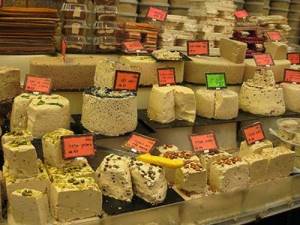
They say that this dessert was invented by the cooks of the Persian kings, but recipes for halva will probably someday be found on cuneiform clay tablets from even more ancient times.
Linguistics testifies to the extreme antiquity of the dish: in all ancient Persian and Arabic dialects, the root of the word halva means “sweetness .”
This sweetness is savored by the heroes of Indian, Assyrian and Arabic legends and, of course, the Arabian Nights fairy tales.
Aladdin orders the genie from a magic copper lamp to set the table with the best halva and sherbet in Baghdad to treat his mother, amazed at the miracles.
Halva was brought to the European coast of the Mediterranean from Central Asia literally at the point of a sword. The Athenians learned about this delicious dessert during the Greco-Persian wars, five hundred years BC.
Since then, the basic recipe for the classic sweet has remained unchanged. It is prepared from roasted nuts or oilseeds crushed into an oily paste and caramelized sugar (honey).
National and local species
- Greek. Consists of walnuts, almonds, semolina, raisins, spices and olive oil.
- Tverskaya. Walnut-sunflower.
- Uzbek. There are several types - with pistachios, walnuts, with milk, with chocolate.
- Samarkand. It is prepared from whipped egg whites, ground into a paste of cashew nuts, cream, vanilla, and sugar. In the middle there is a cashew filling.
- Sheki. You can find cilantro and cardamom in the composition.
- Kokand. Prepared with cream, it contains a large number of “various” nuts and chocolate.
- Azovskaya. Made from sunflower seeds. This is a glazed dessert.
- Ingush. Contains cornmeal and walnuts.
- Chechen. It differs from Ingush only in the type of flour (wheat).
- Tajik. The structure contains caramel fibers.
- Indian. It is prepared with sweet carrots, bottle gourd, spices, nuts, flour, and juices.
- Turkish. Key ingredients: nut butter, sugar, honey.
- Tanzanian. Based on coconut milk.
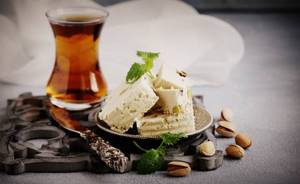
Composition of the product
The chefs prepared the first halva for the Persian king Darius I, a famous lover of sweets. He highly valued skilled cooks and did not skimp on sharing recipes with them. Thanks to this ruler, halva became famous in several countries at once. In the East, it is prepared as a festive and everyday dish, and is also presented as a gift.

The taste of halva depends on its components. Cognac is added for flavor, and sugar or honey adds sweetness to the dessert. Some recipes include vanilla, dried fruits. Halva comes with flour (corn or rice), semolina, nuts and seeds, vegetables (pumpkin, beans or sweet carrots are suitable), and cotton candy. Liquid honey, caramel or chocolate are used as thickeners.
The benefits and harms of sunflower halva depend on the ingredients included in its composition and the method of preparation. The amount of dessert consumed is also of great importance.
Sunflower seeds are used to prepare the dessert. They contain a lot of carbohydrates and proteins: there are about 53 g of them in 100 g of product. Sweet syrup makes the product high in calories (523 kcal per 100 g).
Live healthy! Halva: benefits and harm. 08/06/2018
The benefits of halva during pregnancy and lactation
Almond halva will be especially useful for pregnant women; the product has a positive effect on the formation of several systems of the unborn child at once. If it is not possible to purchase this variety, you can use sunflower halva, which:
- promotes the normal course of pregnancy;
- has a positive effect on the digestive process;
- partially satisfies the body’s need for minerals and vitamins;
- normalizes oxygen metabolism;
- strengthens the heart.
You should not abuse this delicacy, especially in the later stages, as this will contribute to excess weight gain and the onset of diabetes. Nursing mothers can use the product with great caution, as it can cause allergies in the child.
Halva helps restore the body, relieves postpartum depression and helps increase the production of breast milk. But since it belongs to the category of “heavy” food, it is not recommended for women with gastrointestinal diseases to consume it.
In order not to harm your health and figure, you should familiarize yourself with the daily intake of halva: for children over 5 years old - 20-25 g, for those losing weight and pregnant women - no more than 30, for absolutely healthy people - no more than 50 g. Women who have passed the “Balzac age” should reduce the amount of calories they consume, and a “children’s” dose of 20-25 g is recommended.
How to choose the right halva
Before purchasing halva in a store, you should carefully check whether the integrity of the packaging has been damaged. A product that is not hermetically packaged loses a lot in quality because oxygen accelerates the oxidation process of fats, causing them to go rancid.
A high-quality product does not have any stains on the surface, including oil stains. There should be no foreign inclusions inside or on the break in the form of husks or caramel veins. When cutting a product with a knife, it should not crumble, and wrinkled edges are the first sign that the manufacturer has introduced cheap substitutes into the recipe. Only sesame halva has a bitter taste, while sunflower halva has a fibrous-layered structure.
What to look for when choosing
High-quality halva should be:
- without drops of liquid on the surface, which indicate a violation of the production technology and the use of a large amount of caramel mass;
- fibrous texture with white threads of caramel;
- pleasant aroma characteristic of the raw material;
- current expiration date.
Fresh sunflower halva does not stick to the teeth and easily dissolves in the mouth.
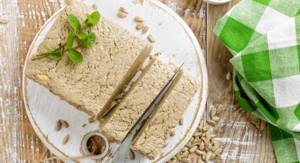
Fresh product
How to prepare halva at home
The most accessible ingredient (and common) is sunflower seeds. If desired, they can be replaced with sesame seeds or peanuts. The recipe for making homemade halva is simple, and you will need:
- Unpeeled, roasted seeds or peanuts - 4 tbsp.
- Wheat flour – 2 tbsp.
- Sugar – 10 tbsp. l.
- Water – 1.5 -2 tbsp.
- Vegetable oil – 1 tbsp. l.
Using a meat grinder, grind the roasted unpeeled seeds. Fry the flour in a dry frying pan until dark golden brown, and mix it with the resulting mass in a suitable bowl. Boil water in a saucepan, pour oil into it and add sugar.
The task is to cook the syrup, which is done over low heat, with constant stirring. Cooking time – 15 minutes. Afterwards, you need to carefully pour the syrup into the prepared mass and mix thoroughly. Wrap the resulting mixture in cellophane and put it in the refrigerator for a couple of hours.
Contraindications
If you are overweight, have an individual intolerance to ingredients, or have a number of diseases, you should avoid eating halva. First of all, this applies to people suffering from:
- acute pancreatitis;
- obesity;
- diabetes mellitus;
- diathesis;
- caries;
- urolithiasis;
- liver pathologies.
Oriental sweets eaten in large quantities will not bring any benefit to the body, since this product contains a lot of fat and sucrose. Also, some manufacturers introduce not very healthy additives into their products, for example, molasses and flavor enhancers.
Main conclusions
Halva can complement the diet of even a person who is losing weight on a diet. Pros of this delicacy:
- unusually healthy and nutritious;
- a natural product, unlike many other desserts;
- replenishes the body's need for glucose, primarily the needs of the brain, provides energy, strengthens the immune system and helps prevent the development of many diseases;
- allows you to carry a child to term and give birth to him strong and healthy.
It is only important to take into account the calorie content, since oriental sweetness has a high energy value. But a small piece of 20-30 grams two or three times a week will not harm your slimness.
Question answer
Is it possible to eat halva if you have type 2 diabetes? Recipes for several types of halva have been developed for diabetics, and all of them are made using sweeteners. A regular product sold in a store is prohibited for use by persons suffering from diabetes, regardless of its type.
Is it possible to eat halva with pancreatitis? If the disease is in the acute stage, then this product is completely excluded from the diet. In the chronic form and in remission, the daily dose of oriental sweets should not exceed 20 g.
Is sunflower halva good for weight loss? A complete refusal of sweets provokes eating and nervous breakdowns. When losing weight, it is better to eat halva prepared independently, consisting of honey, fructose, sunflower seeds and flax. Daily dose – maximum 30 g.
How much can you eat per day?
If a person is healthy, he can eat halva as much as he wants. But given the high calorie content and the danger of gaining extra pounds, you should limit yourself to 35 grams. Still depends on your level of physical activity. If you play sports or do hard physical work, you can eat more, since the calories will be used up.
Important! Halva should not be eaten at once along with chocolate, cheese, meat, and dairy products. This combination of products overloads the digestive system, and in people with pathologies of the digestive system, it can cause heartburn, nausea, heaviness in the stomach, and bloating.




